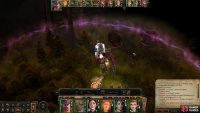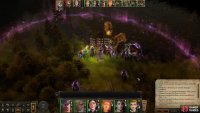A good way to win most fights in Pathfinder: Kingmaker is to simply not get hit. Cheekiness aside, “not getting hit” really has two components - Armor Class (checked against most physical attacks and magical touch/ranged touch attacks) and Saving Throws (checked against most spells and status effects). Saving Throws consist of a Fortitude, Reflex and Will Save, and it’s very difficult for any one character to have overwhelming Saves of each variety, there are a great deal of spells that will protect you from hostile magic, elemental damage and status effects, and your Armor Class will be challenged far more often than your Saves. For those reasons, the primary focus of our tank will be Armor Class, with specific spell buffs being employed to deal with Save-checking threats as the situation demands.
Building a potent tank requires a bit of planning (and a lot of buffing), but it’s worth the effort when a powerful enemy can barely touch you.
Despite being one number, there’s a lot of things that go into Armor Class. A variety of discrete bonuses contribute to your overall Armor Class, the most common of which include: Armor, Shield, Natural Armor, Dexterity, Dodge and Deflection. Typically these bonuses do not stack, so getting the highest Armor Class is more a matter of tapping into these different bonuses rather than merely slapping on the heaviest armor and sturdiest shield you can find. A relatively simple build that attains an absurd Armor Class fairly quickly, can self-buff and deals respectable damage (at the expense of a somewhat slow start) is the Magus (Eldritch Scion)/Monk (Scaled Fist), the latter of which we’re only splashing one level of (at 2nd level) for Crane Style and the ability to add our Charisma modifier to our Armor Class.
There are some rough patches with this build, however, one being that it takes a few levels for this character to really get up and running. Their Armor Class by level three or so should effectively be in the mid-20s without buffs (assuming they’re not blinded or flat-footed), which is good enough to deter most weaker foes like bandits and kobolds, but it’s not quite up to the task of defeating some of the more fearsome foes in Chapter 1. This will take specific buffs and gear that may take some time for you to acquire, and in the meantime, your tank may be better off with a ranged weapon - your pets are more than enough to hold the line for the start of Chapter 1.
An inauspicious start, to be sure, but not the only shortcoming of this class, as its focus on defense leaves it somewhat offensively compromised. Again, this is a short-term issue, mostly caused by the build’s low Strength score, and one that’ll be mitigated as soon as you obtain the Slashing Grace perk, but that’ll take a few levels. In the meantime, use a ranged weapon and let your pets and other characters account for the damage output. This class will never be a top-tier damage dealer, but by around level five they’re holding their own, and when they need to contribute more, class abilities like Spellstrike, Spell Combat and Arcane Weapon Enhancement will allow them to dish out impressive damage spikes when needed.
| The Tank - Starting Stats | Magus (Eldritch Scion) |
|---|---|
| Strength | 7 |
| Dexterity | 16 |
| Constitution | 16 |
| Intelligence | 7 |
| Wisdom | 10 |
| Charisma | 19 |
| Race | Human |
| Bloodline | Draconic (Red/Brass/Gold) |
| Skills | Mobility (3), Persuasion (max) |
| Starting Spells | Shield, Shocking Grasp |
| Feats | Weapon Finesse, Dodge, Crane Style, Weapon Focus, Slashing Grace |
| Alignment | LG |
(1 of 2) The Magus is a class that benefits from micromanagement - capable of bursts of assertive offense,
Magus (Eldritch Scion): The Magus is, in effect, a hybrid warrior/caster, and the Eldritch Scion variant is more in the Sorcerer line of spellcasters rather than the Wizard. This means your character will have some magical bloodline (see below) and has innate magical power. They do not learn spells from scrolls, nor do they have to prepare and memorize specific spells each time they rest. The Eldritch Scion instead possesses a narrower selection of spells that can only be expanded upon when they level up, but you can cast freely among the spells you know at a whim. For the purposes of a hybrid/secondary spellcaster, this works fine - you won’t need a huge arsenal of spells to choose from, just a selection of tried-and-true buffs and offensive spells. The Eldritch Scion also uses Charisma to cast spells instead of Intelligence, like a normal Magus. This will be important when you pick up a level of Monk (Scaled Fist).
In addition, the Magus has a variety of abilities meant to emphasize their mixed martial/magical focus, namely the “Spellstrike”, “Spell Combat”, “Arcane Weapon Enhancement” and “Arcane Accuracy” abilities. The last two both spend charges from the Magus’s “Arcane Pool” in order to use, a total that grows as the Magus levels up, and is replenished every time you rest.
-
With “Spell Combat” active you can cast a spell that requires a standard action and make all your melee attacks in a single round, albeit at a -2 Attack penalty, which is, needless to say, very useful for applying buffs without wasting a combat round, or for comboing with “Spellstrike”.
-
Speaking of which, a Magus can use “Spellstrike” to imbue his weapon with a touch attack spell, which the Magus then gains a free attack with, discharging the spell if the Magus strikes with said weapon. For example, say a Magus normally gets two attacks per round and uses “Spell Combat” to cast Shocking Grasp and also has “Spellstrike” active. The Magus retains their two normal attacks thanks to “Spell Combat” (albeit at a -2 penalty to hit) and get a free attack due to “Spellstrike”, which, if it hits, will discharge Shocking Grasp for 1d6 damage per level (max 5d6).
-
“Arcane Weapon Enhancement” is a little blunt, but it allows the Magus to imbue their weapon with various effects, including enhancement bonuses to Attack and damage, elemental damage, or wider critical threat ranges. Want a +5 Keen weapon? Just expend some charges from your Eldritch Pool, and you’ve got one… for a time. Doing this expends points from your Arcane Pool.
-
Last and not least, “Arcane Accuracy” greatly reinforces the Magus’s somewhat shaky Attack Bonus by allowing them to apply their Charisma bonus to their Attack rolls. You’ll need to use this against high Armor Class foes, or whenever you’re using “Spell Combat”. Doing this expends points from your Arcane Pool.
We suggest hotkeying the four aforementioned abilities, as you’ll want to toggle them on and off as the situation demands.
Monk (Scaled Fist): Unlike the Magus, we’re not really committed to the Monk, but the benefits just a dip into this class gets us is too good to neglect. The Monk normally neglects armor, gaining a bonus to Armor Class equal to their Wisdom modifier due to their special training, but the Scaled Fist variant instead gets a bonus to Armor Class equal to their Charisma modifier. Charisma is already powering our Magus spells… and now, thanks to Scaled Fist, it directly boosts our Armor Class.
You’ll also get a bonus feat from this one level of Monk, which you should spend on picking the “Crane Style” feat. Taking this will allow you to “Fight Defensively” with only a -2 penalty to Attack while gaining a +3 bonus to Armor Class (+4 if you have 3 ranks in Mobility or higher!). With the “Crane Style” and “Dodge” feat, 3 ranks in Mobility, and the ability scores suggested above, you’ll be looking at a 22+ Armor Class without a bit of gear on you - Shield and Mage Armor will both boost this by four, allowing you to hit an Armor Class of 30 before the end of Chapter 1.
Ability Scores: As you can probably tell from the table above, Dexterity and Charisma are the two stats that will really matter for this build, as they’ll contribute greatly to both your offense and defense. You’ll want to spend every point you earn from leveling up (at levels 4, 8, 12, 16 and 20) on Charisma, boosting it to a final score of 24.
Race: There are numerous races that will technically work for this build (Gnome, Halfling, Half-Elf, Half-Orc, Aasimar and Tiefling are all viable), but any inefficiency will make this class harder to get off that ground. For that reason, we suggest sticking with Human, as their bonuses to skill points per level and additional feat at first level will make for smoother sailing.
Alignment: Alignment does matter - a potent robe you’ll find around mid-game requires a character of Lawful Good alignment. It’s not the only robe in the game, but for a tank, Armor Class is king, and for the most Armor Class, you’ll need to be Lawful Good.
Eldritch Bloodline: Picking either Red, Brass or Gold Draconic Bloodline will get you a variety of buffs, many of which will manifest over time. The most notable of these bonuses are Natural Armor (+1 at 3rd level, +2 at 9th level and +4 at 15th level) and Fire Resistance (5 at 3rd level and 10 at 9th level). It’ll also increase the damage you deal with fire spells by +1 per die. Put the two together and you’ll be able to wade into combat and drop area-of-effect fire spells at a whim without damaging yourself too much. Normally this would be a dangerous venture, but for a fire resistant tank, it’s a nuking strategy!
Skills: Honestly not terribly important. Your protagonist will need Persuasion for a lot of story-related dialog choices, and hey! Charisma powers our offense and defense, and will boost Persuasion, too. How about that? Other than that, get Mobility 3 ranks for the boost it’ll give to your ability to “Fight Defensively”, and any other skill points… don’t matter that much. Pick a secondary skill and specialize in it to take the burden off others. Given this character’s high Dexterity, they’ll do well enough in Mobility and Trickery, if you care to boost those.
Feats: Nothing too exciting, here. “Weapon Finesse” allows you to apply your Dexterity bonus to Attack rolls with certain weapons instead of your Strength bonus. You probably won’t do well in melee combat for a while, nor is your Armor Class significantly higher than what a traditional sword-and-board grunt in a steel coffin can achieve, but it’s a prerequisite for the “Slashing Grace” feat, later, which is when things really get good for the Magus. “Dodge” should be pretty self-explanatory for a tank seeking an ever-higher Armor Class… it’s also a prerequisite for some better feats down the line.
Speaking of Slashing Grace, you’re going to need Weapon Focus for that, which requires you to make a commitment. Arguably two of the best weapons for this build in the game are Longsword and Scimitar, and it doesn’t matter which you choose. Also be sure to pick up Crane Style when you dip into Monk at second level.
Starting Spells: Shield will give you a worthy boost to Armor Class, and Shocking Grasp will give you a taste of what this class can do, offensively, both being fine starting spells. If you picked a Draconic Bloodline, you’ll automatically acquire Mage Armor at third level.




No Comments